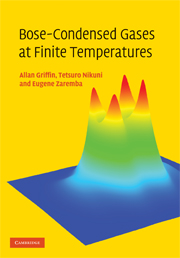Book contents
- Frontmatter
- Contents
- Preface
- 1 Overview and introduction
- 2 Condensate dynamics at T = 0
- 3 Coupled equations for the condensate and thermal cloud
- 4 Green's functions and self-energy approximations
- 5 The Beliaev and the time-dependent HFB approximations
- 6 Kadanoff–Baym derivation of the ZNG equations
- 7 Kinetic equation for Bogoliubov thermal excitations
- 8 Static thermal cloud approximation
- 9 Vortices and vortex lattices at finite temperatures
- 10 Dynamics at finite temperatures using the moment method
- 11 Numerical simulation of the ZNG equations
- 12 Simulation of collective modes at finite temperature
- 13 Landau damping in trapped Bose-condensed gases
- 14 Landau's theory of superfluidity
- 15 Two-fluid hydrodynamics in a dilute Bose gas
- 16 Variational formulation of the Landau two-fluid equations
- 17 The Landau–Khalatnikov two-fluid equations
- 18 Transport coefficients and relaxation times
- 19 General theory of damping of hydrodynamic modes
- Appendix A Monte Carlo calculation of collision rates
- Appendix B Evaluation of transport coefficients: technical details
- Appendix C Frequency-dependent transport coefficients
- Appendix D Derivation of hydrodynamic damping formula
- References
- Index
1 - Overview and introduction
Published online by Cambridge University Press: 06 October 2009
- Frontmatter
- Contents
- Preface
- 1 Overview and introduction
- 2 Condensate dynamics at T = 0
- 3 Coupled equations for the condensate and thermal cloud
- 4 Green's functions and self-energy approximations
- 5 The Beliaev and the time-dependent HFB approximations
- 6 Kadanoff–Baym derivation of the ZNG equations
- 7 Kinetic equation for Bogoliubov thermal excitations
- 8 Static thermal cloud approximation
- 9 Vortices and vortex lattices at finite temperatures
- 10 Dynamics at finite temperatures using the moment method
- 11 Numerical simulation of the ZNG equations
- 12 Simulation of collective modes at finite temperature
- 13 Landau damping in trapped Bose-condensed gases
- 14 Landau's theory of superfluidity
- 15 Two-fluid hydrodynamics in a dilute Bose gas
- 16 Variational formulation of the Landau two-fluid equations
- 17 The Landau–Khalatnikov two-fluid equations
- 18 Transport coefficients and relaxation times
- 19 General theory of damping of hydrodynamic modes
- Appendix A Monte Carlo calculation of collision rates
- Appendix B Evaluation of transport coefficients: technical details
- Appendix C Frequency-dependent transport coefficients
- Appendix D Derivation of hydrodynamic damping formula
- References
- Index
Summary
Since the dramatic discovery of Bose–Einstein condensation (BEC) in trapped atomic gases in 1995 (Anderson et al., 1995), there has been an explosion of theoretical and experimental research on the properties of Bose-condensed dilute gases. The first phase of this research was discussed in the influential review article by Dalfovo et al. (1999) and in the proceedings of the 1998 Varenna Summer School on BEC (Inguscio et al., 1999). More recently, this research has been well documented in two monographs, by Pethick and Smith (2008, second edition) and by Pitaevskii and Stringari (2003). Most of this research, both experimental and theoretical, has concentrated on the case of low temperatures (well below the BEC transition temperature, TBEC), where one is effectively dealing with a pure Bose condensate. The total fraction of noncondensate atoms in such experiments can be as small as 10% of the total number of atoms and, equally importantly, this low-density cloud of thermally excited atoms is spread over a much larger spatial region compared with the high-density condensate, which is localized at the centre of the trapping potential. Thus most studies of Bose-condensed gases at low temperatures have concentrated entirely on the condensate degree of freedom and its response to various perturbations. This region is well described by the famous Gross–Pitaevskii (GP) equation of motion for the condensate order parameter Φ(r, t). As shown by research since 1995, this pure condensate domain is very rich in physics.
The main goal of the present book, in contrast, is to describe the dynamics of dilute trapped atomic gases at finite temperatures such that the noncondensate atoms also play an important role.
- Type
- Chapter
- Information
- Bose-Condensed Gases at Finite Temperatures , pp. 1 - 18Publisher: Cambridge University PressPrint publication year: 2009



